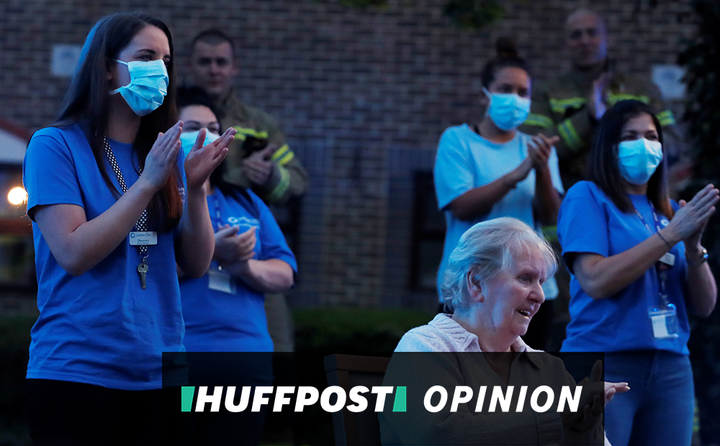
The Covid-19 outbreak is shining a blinding light on the state of our economy: we can no longer look away from the big questions about how fit for service our health and social care systems are, how humane our social security system is, and whose jobs are really essential to the functioning of society.
As the UK marks a month in lockdown, analysis of who is facing the brunt of this crisis is emerging. Men are at higher risk of dying from Covid-19, while women are at greater risk from the economic crisis caused by the lockdown. Women are the majority of workers with highest exposure to Covid-19: 77% of the 3.2 million workers in “high risk” roles are women. Many of these high-risk roles are paid poverty wages – and women make up a staggering 98% of those jobs.
Get the latest on coronavirus. Sign up to the Daily Brief for news, explainers, how-tos, opinion and more.
Black, Asian and minority ethnic groups are also over-represented in front-line, high-exposure jobs, and this has been suggested as a reason why people from these groups are disproportionately contracting, and dying from, Covid-19. The government has now announced it will investigate this in a formal review.
One of the most high-risk sectors is social care. While outpourings of support for the NHS, both from the government and the public, have been forthcoming, social care has once again been an afterthought. Health and social care secretary Matt Hancock was last week derided for presenting a pin badge honouring social care workers alongside vague promises to increase testing and supplies of personal protective equipment in care homes, despite the badge actually having been released in spring 2019. MP for Nottingham East, Nadia Whittome, who worked as a care worker before becoming an MP, and who has returned to care work part-time since the outbreak, responded to the badge by asking how her colleagues could “cash this in for a real living wage?”
But this isn’t new: systematic neglect of the care sector has been a consistent feature of the last few years. The crucial, life-sustaining and life-enriching work that carers do continues to be undervalued, underpaid, and under-resourced. And it has taken a global pandemic for this to come to light.
We’re seeing a staggering amount of Covid-19 deaths occurring in care homes when they are counted (in other European countries), but chronic under-counting of deaths in care homes, or in people’s own homes in the UK. Care home providers complain that the care sector is struggling to cope with staff shortages and a lack of personal protective equipment. The lives and wellbeing of older people and disabled people living in care homes, as well as those caring for them, are being neglected. And guess what? Women are disproportionately represented in both groups: the majority of people who require care are women, and 83% of social care workers are women. And 1 in 5 care workers are migrant workers.
Why is it that there are more women in these low-paid, frontline jobs, such as social care? The Women’s Budget Group argues that, through spirals of inequality, women’s unpaid care work has a knock-on impact on so many other parts of the economy. Women do more unpaid care and domestic work (60% more, in fact), so it is seen as “natural” that they do more paid care work too. And this care work is hugely underpaid (the median hourly pay for a care worker is £7.40), because it’s seen as an extension of the unpaid care work women do at home and in the community.
Women’s caring responsibilities also mean they have less time for paid work, so they go for part-time work, which is local to home, which restricts their job choices, and results in lower-paid work (women are 69% of workers on low pay).
This, in turn, has implications on lifetime earnings, poverty in older age, how women and men are impacted differently by changes to taxes, social security and public service provision, and whose voices are heard in decision-making positions. We’ve never seen this more clearly than now, when every evening men dominate the daily Westminster press conferences and all the major decision makers are men. Is it any wonder that social care, a sector dominated by women, continues to be neglected, despite unprecedented urgency for reform?
But the growing attention paid to social care by the media in the last few days gives reason for hope. Across the political spectrum, we are seeing an acceptance that things have to change, and that our economy is not fit for purpose. With Piers Morgan declaring that ”care workers 100% deserve the same recognition as NHS workers”, and the Financial Times editorial accepting the necessity of “radical reforms, reversing the prevailing policy direction of the last four decades”, perhaps this is the point at which we start to do things differently. This brings hope for fundamental change, hope for a widespread rethinking of whose jobs are really crucial, and hope that the contribution of migrant key workers will be truly valued, instead of being dismissed as ”low-skilled”. The turning point. When, finally, care work – both paid, and unpaid – is valued for what it is: the backbone of the economy. But we have to ask, why did it take a global pandemic for us to sit up and listen to women about care?
Marion Sharples is project manager and researcher for the Women’s Budget Group commission on a gender-equal economy.
